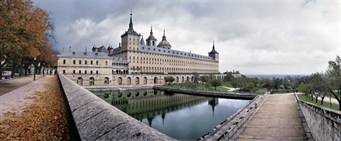Herrera style
 The Herrera style is an architectural style that developed in Spain from the middle of the sixteenth century, coinciding with the construction of the palace-monastery of El Escorial built by Philip II. The name is derived from the architect Juan de Herrera (1530-1597), who designed the project. The Herrera style is considered as the last stage of the Spanish Renaissance, and its main feature is the constant use of the wall, bereft of decorations, to give a feeling of great bulk. The roofs of the buildings, almost always made ??of wood, are covered with slate and surmounted by capitals with a typical pyramidal tip.
The Herrera style is an architectural style that developed in Spain from the middle of the sixteenth century, coinciding with the construction of the palace-monastery of El Escorial built by Philip II. The name is derived from the architect Juan de Herrera (1530-1597), who designed the project. The Herrera style is considered as the last stage of the Spanish Renaissance, and its main feature is the constant use of the wall, bereft of decorations, to give a feeling of great bulk. The roofs of the buildings, almost always made ??of wood, are covered with slate and surmounted by capitals with a typical pyramidal tip.
Read more:
- J. I. Linazaroso, El Clasicismo Herreriano: ¿Un proyecto interrumpido?, in Herrera y el clasicismo: ensayos, catálogo y dibujos en torno a la arquitectura en clave clasicista, Junta de Castilla y León 1986, pp. 15-20.
- A. Bustamante García, Juan de Herrera y El Escorial, in J. Gómez Martínez, M. Á. Aramburu-Zabala Higuera (coords.), Juan de Herrera y su influencia: actas del simposio, Camargo, 14-17 julio 1992, Santander 1993, pp. 17-26.
